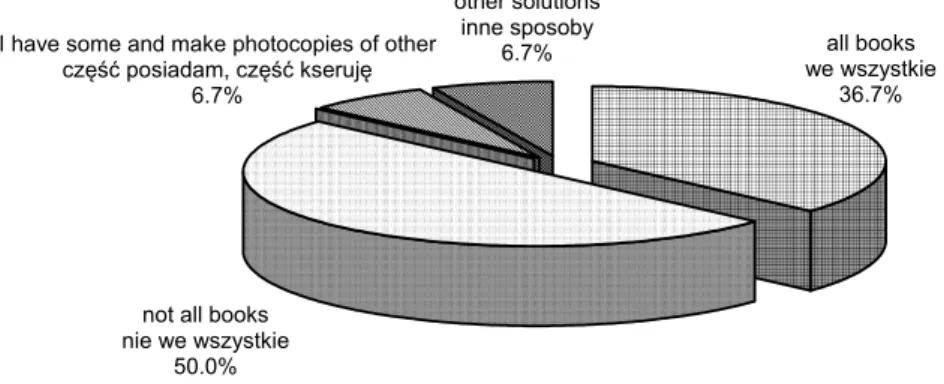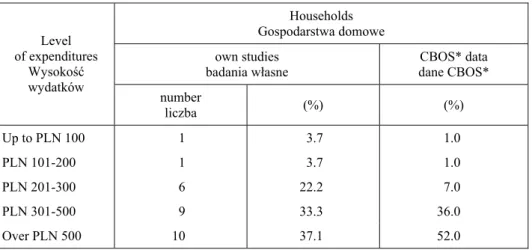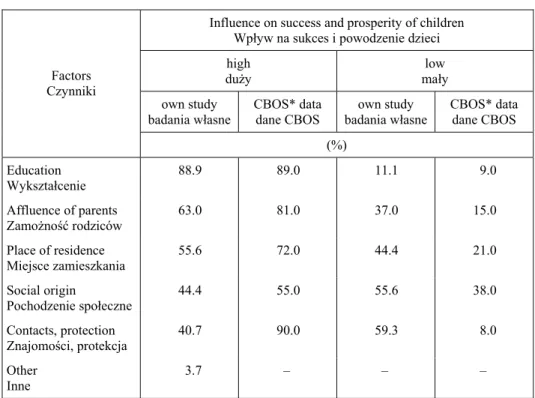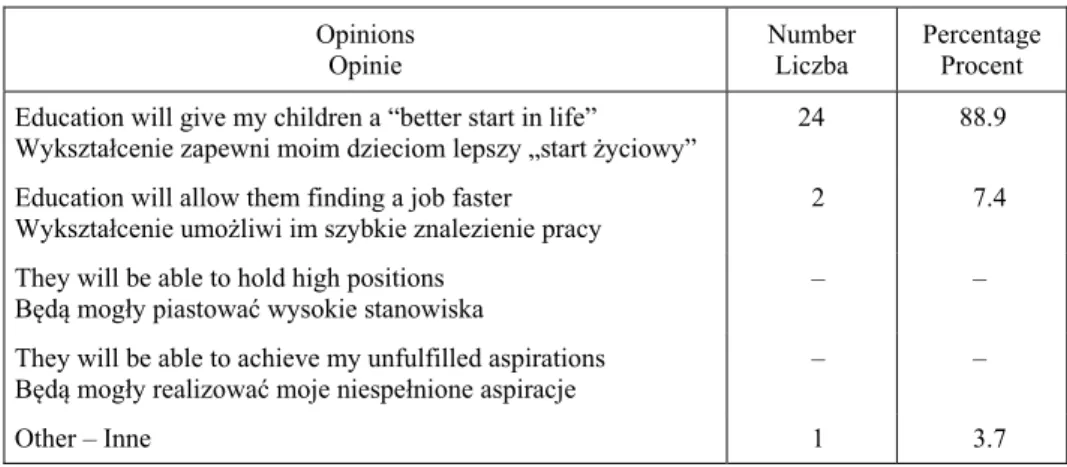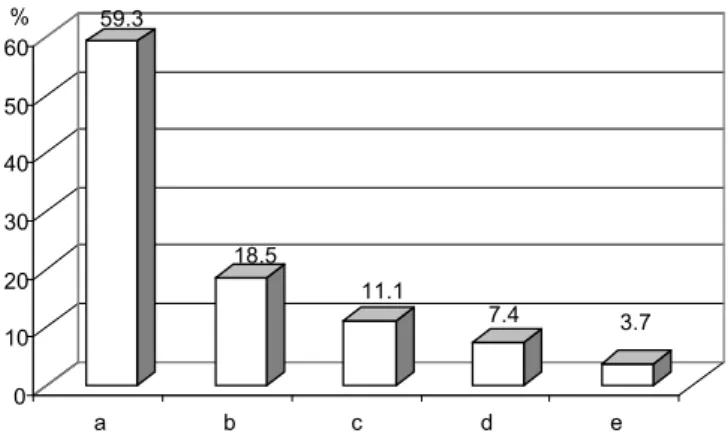Rocz. AR Pozn. CCCLXXXV, Ekon. 6: 85-95
© Wydawnictwo Akademii Rolniczej im. Augusta Cieszkowskiego w Poznaniu, Pozna 2007 PL ISSN 1731-0261
RENATA MARKS-BIELSKA, ROMAN KISIEL
EDUCATIONAL BARRIERS AND OPPORTUNITIES
FOR YOUTH FROM AREAS OF FORMER
STATE-OWNED FARMS BASED ON THE EXAMPLE
OF GRODZICZNO MUNICIPALITY
From Department of Economic and Regional Policy of University of Warmia and Mazury in Olsztyn
ABSTRACT.This paper aims at presenting the results of studies conducted in Grodziczno munici-pality in the province of Warmia and Mazury concerning educational barriers and opportunities for lower secondary school youth from areas of former State-owned farms.
Key words: education, farmer State-owned farms
Introduction
Education has become the foundation of development of the contemporary world – knowledge based economy and learning society. Educated society is the “capital” de-termining achievement of both economic goals, which is confirmed by the theories of human capital and experiences from development of the so-called industrialized coun-tries, as well as basic human rights and human development goals. Investments in hu-man capital are long-term investments. They represent one of the main factors stimulat-ing socio-economic development and determinstimulat-ing the level of international competi-tiveness of the economy (Kisiel and Marks-Bielska 2002, Marks-Bielska and Biał o-brzeska 2005).
Education is the basic method of acquiring human capital in contemporary econo-mies. In case of the analysis of the influence of education on economic growth and other components of social welfare attention is drawn to the quantitative aspects of education as well as attempts are made to measure the influence of the qualitative aspects of edu-cation (Na prostej?... 2003). In Poland, however, eduedu-cation is becoming relatively ex-pensive and money becomes the increasingly important criterion of selection in access to education. This is of particular importance in Warmia and Mazury voivodship where low level of wealth is one of the basic social problems. Before the systemic transforma-tion, around 50% of agricultural land in the area was owned by State-owned Farms (PGR). At the beginning of 1990, there were more than 100 large, agricultural enter-prises and companies consisting of multiple units within the area of the present Warmia and Mazury voivodship. State-owned agriculture of the region employed ca. 65 000 people.
Former State-owned Farms are locations of multiplication and accumulation of many negative phenomena such as unemployment, poverty, marginalization, lack of perspectives and pathologies. Those phenomena and processes in an obvious way draw attention to the young generation that represents an important link in the process of passing the economic achievements, social and cultural capital within the family. It is well known that poverty and unemployment in those communities had and still have influence on the current situation and prospects for the future of the children of former employees of the State-owned farms growing up within new circumstances and, fre-quently, experiencing a very difficult financial situation of the family (Tarkowska and Korzeniewska 2002).
Youth is an important period of human life during which the system of values de-velops. This is the time of formation of specific behavioral patterns and methods for achievement of goals (Sikora 2001). According to Tarkowska (2002), the attitude of rural youth to education, its aspirations and educational careers represent an important, current subject worth serious consideration by researchers of the transformation, the more so as deep changes take place in the area of education at a rapid pace. At present, a similar percentage of rural and urban youth takes the decisions concerning continuation of education but the conditions for implementation of educational aspirations are still much more difficult for the rural than for the urban youth (Kapitał społeczny... 2004).
Methodological assumptions of the studies
The questionnaire-based study was carried out at the turn of November and Decem-ber 2004. The timeframe of the analysis covered the years 1989–2004. The empirical studies were of dynamic nature. The questions included in the questionnaire offered the possibility of analysing interesting phenomena from the period preceding the studies as well as such phenomena for the future on the basis of plans, opinions and expectations of the respondents. The study was conducted in the municipality of Grodziczno, county of Nowe Miasto, Warmia and Mazury voivodship where formerly 3 State-owned Farms: Linowiec, Montowo and Katlewo were situated.
Discussion of the results of studies
The possibility of continuing education after completing the lower-secondary school was one of the issues studied. The majority of answers provided by the parents of stu-dents (53.3%) indicated that they could cover the costs of further education of their children to a minor extent only. That is why many of the lower-secondary school stu-dents will not be able to continue their education for economic reasons. Almost a half (43.3%) of the respondent parents stated that covering the costs was impossible. Only one respondent answered that he could cover the full costs. Another issue covered by the study was the financial capacity of the parents to equip the children with basic course books (Fig. 1).
Fig. 1. Provision of youths from former State-owned farms with school course books Source: own work based on the results of studies.
Ryc. 1. Wyposa enie młodzie y popegeerowskiej w podr czniki szkolne ródło: opracowanie własne na podstawie wyników bada .
Data provided by CBOS indicates that the larger the number of children in the fam-ily the lower amounts are allocated to course books by parents (per one child). That situation is linked mainly to the financial standing of the family. The children have various opportunities to use course books when the parents cannot afford buying them.
A half of the students was equipped with school course books, but not with all of them. Students, whose parents purchased all the books represented 36.7% of the
popula-all books we wszystkie
36.7%
not all books nie we wszystkie
50.0%
other solutions inne sposoby
6.7% I have some and make photocopies of other
czę ć posiadam, czę ć kseruję 6.7%
tion. None of the respondent students used the books at the reading room or borrowed them from friends. Only two persons answered that they possessed only some of the books while they made photocopies of the others. Borrowing books from a library is another possibility of obtaining course books. In case of two students some books were borrowed from a library while the rest was purchased by the parents.
Provision of the children with schoolbooks is closely correlated with the material standing of the family. Parents spend the largest amounts on education before every new school year. The expenditures related to the beginning of the school year include such as schoolbooks, educational equipment and compulsory fees such as the insurance. The results of the studies conducted are compared with the data presented by CBOS in the following table (Table 1).
Table 1 Expenditures related to commencement of the school year according to the respondent parents
Wydatki związane z rozpoczęciem roku szkolnego według ankietowanych rodziców
Households Gospodarstwa domowe
own studies badania własne
CBOS* data dane CBOS* Level
of expenditures Wysokoć wydatków
number
liczba (%) (%)
Up to PLN 100 1 3.7 1.0
PLN 101-200 1 3.7 1.0
PLN 201-300 6 22.2 7.0
PLN 301-500 9 33.3 36.0
Over PLN 500 10 37.1 52.0
*The CBOS data does not add to 100 because of the additional answer: “undetermined amount” (expenditures incurred but the amount was not specified by the respondents).
Source: own work based on the information by CBOS (2004) and own studies.
*Dane CBOS nie sumuj si do 100 ze wzgl du na dodatkow odpowied : „nieokre lone wy-datki” (wydatki, które zostały poniesione, lecz ich wysoko ć nie została okre lona przez respon-dentów).
ródło: opracowanie na podstawie informacji CBOS (2004) i bada własnych.
The conducted studies show that in 2004 two families allocated less than PLN 200 for expenditures related to commencement of the school year. According to the data by CBOS, the majority of families (52.0%) spend more than PLN 500 for the purpose. Among the post-State-owned farm families 37.1% incurred expenditures exceeding PLN 500. Similar to the studies by CBOS, such households represented the highest percentage among the group covered.
de-pends, among others, on the social position, material standing and education. The higher the education and better the material standing are the lower the technological barriers. Internet is the tool very useful to the young generation. The young people, using the Internet, prepare for classes and obtain information from many different areas.
The majority of young people from former State-owned farm communities answered “no” to the question “Do you possess access to the Internet?” The majority also an-swered that they use the Internet only during the information sciences classes (63.3%) while 16.7% of the respondents used the Internet at the reading room and 13.3% used it occasionally (at their friends, at an Internet café). Only 2 persons (6.7%) had access to the Internet at home. Also 2 persons answered that they did not use the Internet at all as the financial standing of the family does not allow purchase of the equipment while they did not have classes in information sciences.
Comparing the data obtained from the studies with the results obtained by CBOS it can be concluded that the youth from former State-owned farm communities has limited access to the Internet. Students from Grodziczno municipality have fewer opportunities to use the Internet network at school as compared to the national data. The number of people from families of former State-owned farm employees using the Internet at home differs immensely from the numbers given in the CBOS studies. For comparison, among lower-secondary school students 6.7% possess access to the network while ac-cording to the results presented by CBOS 50.0% of the respondents used the Internet at home (Table 2).
Table 2 Places where the youth uses the Internet
Miejsca, w których młodzież korzysta z Internetu
Own studies Badania własne
CBOS data Dane CBOS Place
Miejsca
(%)
School – Szkoła 63.3 76.0
Home – Dom 6.7 50.0
Source: own work based on the information by CBOS (2004) and own studies. ródło: opracowanie własne na podstawie informacji CBOS (2004) i bada własnych.
The level of abilities represents a very important factor determining the opportuni-ties of the young generation for the future. The level of those abiliopportuni-ties can be repre-sented by participation in subject Olympics (competitions for students in knowledge on various subjects covered by the curriculum; Table 3).
Analysis of the data presented in Table 3 indicates that two students always partici-pate in the Olympics, 40.0% of the youth from former State-owned farm communities answered that they participated in the Olympics sometimes while more than a half of the lower-secondary school students do not participate in the Olympics at all.
Table 3 Participation of the youth from former State-owned farm communities in subject Olympics
Uczestnictwo młodzieży popegeerowskiej w olimpiadach
Participation in the Olympics Uczestnictwo w olimpiadach
Number of answers Liczba odpowiedzi
Percentage of answers Procent odpowiedzi
Always Zawsze
2 6.7
Sometimes
Czasami
12 40.0
I do not participate Nie uczestnicz
16 53.3
Source: own work based on the results of own studies. ródło: opracowanie własne na podstawie wyników bada .
as concerns the number of attending students with 32.8% share (Rocznik statystyczny... 2003). The studies showed that all lower-secondary school students attended English at school. Two persons additionally attended private lessons. The possibilities of partici-pating in paid forms of education is linked to the economic standing of households. An additional form of education such as, e.g. private tutorial in a foreign language influ-ences the educational opportunities of students and, as a consequence, their social posi-tion in the future.
All the above-presented factors influencing educational opportunities of the youth are linked to, among others, the material standing of the households. That standing also influences significantly the abilities of the student to learn. An example here could be the place in which the child works on the homework and learns. The studies conducted showed that every fifth family had only one room. The average number of people living in such apartments was 4.33 persons. The largest proportion of the youth (43.3%) de-clared that they shared the room with their siblings. The average number of children in those households was 4.77. Only 36.7% of the respondent lower-secondary school stu-dents had their own room.
The distance between the school and the place of residence plays an important role in the daily life. The sample covered consisted of lower-secondary school students liv-ing in the area of 3 former State-owned Farms, i.e. the youth comliv-ing from different villages.
According to the answers provided by the respondent students, 60.0% of them must travel between 2 and 5 km to school. Every tenth student had to travel more than 5 km to school. Students belonging to 9 households covered the distance of up to 2 km. The distance to school is linked to the means of travel to and from school. The vast majority of students (93.3%) traveled to school by bus, which was a special school bus, while 2 persons walked to school. Those were the students living up to 2 km away from the lower-secondary school.
the students planned to attend the local secondary technical school. The material stand-ing of their families did not allow coverstand-ing the costs involved in continuation of their education or allowed covering only a part of such costs. Factors such as education, social origin, level of affluence of the parents, contacts, protection and place of resi-dence are factors conditioning the success and prosperity in the lives of the children. Those factors influence the lives of the young generation with diversified force (Ta-ble 4).
Table 4 Factors influencing success and prosperity of children according to parents
Czynniki wpływające na sukces i powodzenie dzieci w opinii rodziców
Influence on success and prosperity of children Wpływ na sukces i powodzenie dzieci
high du y
low mały
own study badania własne
CBOS* data dane CBOS
own study badania własne
CBOS* data dane CBOS Factors
Czynniki
(%)
Education Wykształcenie
88.9 89.0 11.1 9.0
Affluence of parents Zamo noć rodziców
63.0 81.0 37.0 15.0
Place of residence Miejsce zamieszkania
55.6 72.0 44.4 21.0
Social origin
Pochodzenie społeczne
44.4 55.0 55.6 38.0
Contacts, protection Znajomo ci, protekcja
40.7 90.0 59.3 8.0
Other Inne
3.7 – – –
*CBOS data do not total to 100 because the additional answer: “hard to say”. Source: own work based on the information by CBOS and own studies.
*Dane CBOS nie sumuj si do 100 ze wzgl du na dodatkow odpowied : „trudno powie-dzieć”.
ródło: opracowanie własne na podstawie informacji CBOS i bada własnych.
In our study the number of respondents considering affluence of parents to be the most important factors is lower by 18.0% than the number of such respondents in CBOS data. Also fewer people from post-State-owned farm population believe that the place of residence is of major importance for success and prosperity. The number of such re-spondents is 16.4% fewer than among the rere-spondents to the CBOS study.
Among many factors that the respondents considered of low importance for achievement of success and prosperity 2 are on the leading positions. They are contacts and protection (59.3%) and social origin (55.6%). Also among CBOS respondents the majority answered that social origin was the factor with low influence on success of children (38.0%).
Attitudes of the young generation are highly influenced by attitudes and behaviors of the parents determined by their vocational position and social status. Also conditions of education determined by opportunities offered by the education system and the educa-tional aspirations of the youth are important. Those opportunities determine the life opportunities and influence the probability that the young people will find themselves at the same positions in the social structures as their parents (Marginalno ć... 1999, Po-ławski 1999).
The more frequently the parents consider education a very important factor facilitat-ing the lives of the children the more effort they take to give them appropriate educa-tion. According to the answers given by the respondent parents (Table 5), the largest number of the respondents would like their children to receive appropriate education as that would give them a “better start in life” (88.9%). According to 7.4% of the respon-dents education allows quick finding of a job. Only one person answered that appropri-ate education would allow the children taking a job and residence in town.
Table 5 Parents’ opinions on appropriate education of their children
Opinie rodziców na temat starannego wykształcenia ich dzieci
Opinions Opinie
Number Liczba
Percentage Procent
Education will give my children a “better start in life” Wykształcenie zapewni moim dzieciom lepszy „start yciowy”
24 88.9
Education will allow them finding a job faster Wykształcenie umo liwi im szybkie znalezienie pracy
2 7.4
They will be able to hold high positions B d mogły piastować wysokie stanowiska
– –
They will be able to achieve my unfulfilled aspirations B d mogły realizować moje niespełnione aspiracje
– –
Other – Inne 1 3.7
Source: own work based on the results of own studies. ródło: opracowanie własne na podstawie wyników bada .
Fig. 2. Declared activities of parents aimed at improving the mate-rial standing of the family: a – taking up an occasional job, b – tak-ing up a job in town, c – movtak-ing abroad for permanent stay, d – change of the place of residence, e – improving own vocational
qualifications
Source: own work based on the results of own studies. Ryc. 2. Deklarowane działania rodziców w celu polepszenia sytu-acji materialnej rodziny: a – podj cie okazyjnej pracy, b – podj cie pracy w mie cie, c – wyjazd na stałe za granic , d – zmiana miejsca zamieszkania, e – podniesienie swoich kwalifikacji zawodowych
ródło: opracowanie własne na podstawie wyników bada .
Among the respondent parents, more than a half (59.3) was ready to take an occa-sional job, not necessarily consistent with their qualifications. On the other hand 10 persons could improve their vocational qualifications to work in a different vocation. Every fifth person wanted to take a job in town. Only two respondents pointed out that they could change the place of residence to get a job offerring an apartment at the same time. All those activities aim at improving the material standing of the family. Some persons declared that they would be ready to satisfy a number of conditions at the same time to improve the economic standing. One person could improve the vocational quali-fications to be able to work in a different vocation, take up an occasional job, not neces-sarily in line with the qualifications and take up a job in town.
Unfortunately the respondent parents very rarely take up specific actions aimed at improvement of the economic standing of their families and allowing obtaining appro-priate education by their children. The activities specified by the parents covered by the study in their vast majority remained just declarations.
Conclusion
The youth living in settlements of former State-owned farms has very limited possi-bilities of gaining education and implementing their further plans for life. Among the respondents – lower-secondary school students 50.0% was equipped with some course books only. Covering further education related expenses is another important issue.
59.3
18.5
11.1
7.4 3.7
0 10 20 30 40 50 60 %
Almost a half of the respondents (43.3%) stated that covering those costs was impos-sible.
The attitude of parents to education of their children is positive. Although the major-ity of them has low level of education as only 5 persons had secondary education and that was the highest level of education in the studied population, when asked their opin-ions on education of their children the majority of them (88.9%) responded that it was very important and it could give their children a “better start in life”. The same percent-age of parents perceived appropriate education of their children as a factor of major influence on their success and prosperity in the future.
A very important thing for allowing achievement of life plans of the youth is that their parents should take specific actions and not only, as in case of the vast majority of the respondents, declare willingness of taking them. Such activities include those aim-ing at improvaim-ing the material status. More than a half of the parents (59.3%) was ready to take up occasional jobs, not necessarily consistent with their qualifications and every third parent declared willingness to improve vocational qualifications to be able to work in a different vocation.
Without institutional help of the State in removing barriers to access to education of the youth from former State-owned farm communities is far from possible. The Agency of Agricultural Property, as of January 1, 2005, has not taken any actions aimed at voca-tional activation and social assistance to former employees of State-owned farms. The only program implemented until June 30, 2005 was the program of scholarships.
The Council of Ministers, in the Resolution 39/2006 of March 28, 2006, approved the Government program for equalizing the educational opportunities of students from families of former State-owned agricultural enterprises for the years 2006-2008, which is a part of the National Program of Scholarships included in the list of Government strategic documents. This program continues the program of scholarships implemented by the Agency of Agricultural Property targeted at students starting education at public secondary schools offering the opportunity to obtain the certificate of secondary educa-tion.
The Program of Gap-Closing Scholarships implemented by the Enterprise Educa-tional Foundation operating in agreement with the NaEduca-tional Bank of Poland, Polish-American Freedom Foundation, Bank Pocztowy S.A., PZU Foundation, Jan Kanty Steczkowski Foundation, BRE Bank S.A. Foundation and Polskie Młyny S.A. company with organizational support of the Agency of Agricultural Property can represent an-other step in acquiring funds for further education of youth from families of former employees of State-owned farms. The program aims at helping such youth in overcom-ing the barriers involved in startovercom-ing education at a tertiary school by fundovercom-ing scholar-ships for the first year of full time master degree studies.
An opportunity can also be offered by the European Union Structural Funds (Inte-grated Regional Development Operational Program) within e.g. measure – equalizing educational opportunities through scholarship programs. The scholarships are intended for students from marginalized areas and for sure areas of former State-owned farms are such areas.
Literature
Kapitał społeczny i ludzki. (2004). In: Polska wie po wej ciu do Unii Europejskiej. FDPA, Fun-dacja na Rzecz Rozwoju Polskiego Rolnictwa: 79-104.
Kisiel R., Marks-Bielska R. (2002): Edukacja szans awansu społecznego młodzie y ze rodo-wisk popegeerowskich. Polit. Społ. 10: 17-20.
Marginalnoć i procesy marginalizacji. (1999). Ed. K. Frieske. IPiSS, Warszawa.
Marks-Bielska R., Białobrzeska R. (2005): Koniecznoć inwestowania w kapitał ludzki w warun-kach globalizacji. In: Nierówno ci społeczne a wzrost gospodarczy. Uniwersytet Rzeszowski, Katedra Teorii Ekonomii, Rzeszów: 147-156.
Na prostej? Polska w przededniu członkostwa w UE. EU – monitoring VII. (2003). Eds M. Morody, J. Wilkin. Małopolska Szkoła Administracji Publicznej AE, Fundacja im. Friedricha Eberta, Kraków.
Poławski P. (1999): Marginalnoć społeczna i wychowanie. Polit. Społ. 11-12: 21-25. Rocznik statystyczny woj. warmi sko-mazurskiego. (2003). US, Olsztyn.
Sikora E. (2001): Młodzie o swej sytuacji, planach, d eniach yciowych i zawodowych. In: Mieszka cy osiedli byłych pegeerów o swojej sytuacji yciowej. Ed. Z. Kawczy ska-Butrym. Studio Poligrafii Komputerowej „SQL” s.c., Olsztyn: 51-63.
Tarkowska E. (2002): Miejsce i rola wykształcenia w biografiach młodych ludzi z byłych PGR-ów. In: Młodzie z byłych PGR-ów. Raport z bada . Inst. Spraw Publ., Warszawa: 18-70.
Tarkowska E., Korzeniewska E. (2002): Młodzie z byłych PGR-ów. Raport z bada . Inst. Spraw Publ., Warszawa.
BARIERY I SZANSE EDUKACYJNE MŁODZIE Y Z TERENÓW
POPEGEEROWSKICH NA PRZYKŁADZIE GMINY GRODZICZNO
S t r e s z c z e n i e
Artykuł ma na celu przedstawienie wyników bada przeprowadzonych na terenie gminy Gro-dziczno w woj. warmi sko-mazurskim, dotycz cych barier i szans edukacyjnych młodzie y gimnazjalnej z terenów popegeerowskich.
